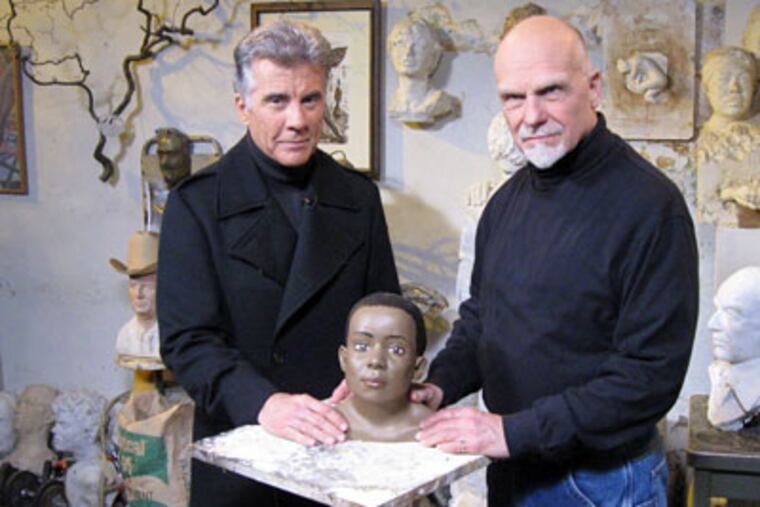Two area mysteries on 'Most Wanted'
One segment is S. Phila. killing of Beau Zabel, aspiring teacher.

Standing in front of a painted killer in a cowboy hat and a Bob Marley with wilder hair than Medusa, John Walsh stared into the TV cameras, explaining his mission to identify a girl "thrown away like a pile of garbage."
A new big clue was about to be revealed.
Frank Bender, forensic sculptor, stepped forward in the studio of his South Street home. He pulled away a large black cover to display a tiny head - one with large brown eyes and a gently rounded nose amid a soft, brown complexion.
Tonight at 9 on America's Most Wanted on Fox, this scene, shot Tuesday, will be part of "Baby Bones," a story of the mysterious remains of a 5- to 8-year-old child found in 2005 in the woods in Monmouth County.
It will be the longest of at least two segments with a Philadelphia angle.
Also featured will be the South Philadelphia murder of Beau Zabel, an aspiring teacher gunned down June 15 for his iPod. The show examined the case in July, but with the killer still unknown, show host Walsh himself came to town to retrace Zabel's steps and rebroadcast surveillance video of a possible suspect. (To view footage of the "person of interest," go to http://go.philly.com/zabelvideo.)
Walsh also talked with Philadelphia Detective Levi Morton, who hopes people reluctant to contact police will call the show's anonymous tip line, 1-800-274-6388 (1-800-CRIMETV).
The strong-featured, white-goateed Bender, almost a ringer for actor Malcolm McDowell, has helped solve many cases.
Walsh gushed about Bender's help in bringing John List to justice in 1989, nearly two decades after the New Jersey accountant killed his wife and family.
List's likeness was the one with the cowboy hat.
America's Most Wanted tackled that case because of a direct challenge from the FBI, Walsh said.
Closer to home, Bender also helped solve the infamous case of the "Boy in a Bag."
A bag containing a boy's body was found under the Ben Franklin Bridge in 1994, and his identity stayed a mystery until 2005, when a relative saw a bust by Bender online.
Jerell Willis' mother, Alicia Robinson, was convicted in 2007 of helping dispose of the body, while husband Lawrence - not the child's father - awaits trial later this year for the murder.
More than 20 busts - the faces of wanted fugitives and unidentified victims - fill four shelves in the cluttered studio.
For the cameras, Bender explained how he put soft clay over the victim's skull to shape the likeness. The bust is a painted copy made of fiberglass-reinforced plaster created from a mold.
"It's a balance of art and science," Bender explained on-camera. "You cannot get an accurate rendition if you just follow science. You cannot get an accurate rendition if you just follow art."
The girl's complexion could have been darker or lighter. Perhaps she was part Hispanic, Walsh said.
Her hair was probably different, said Bender, who depicted the hair pulled back to better show the face.
The girl, whose burned remains went undiscovered for at least a year, may have been abused, because she was apparently malnourished and had suffered a broken rib, said Donna Fontana, a New Jersey State Police forensic anthropologist, who took part in the filming.
Investigators have concluded the disappearance was probably never reported, suggesting that the child died at the hands of someone responsible for her care.
Walsh also hopes viewers will help crack the Zabel case, even though surveillance clips don't clearly show the suspect's face.
"Absolutely," Walsh said after the filming. "I've caught people with very grainy, grainy video. . . . We've caught people just off logos on their sweatshirts, logos on their baseball caps, their habits of smoking a certain kind of cigarette or beer. We even caught a guy because he sang the same song in a bar all the time."
The show got interested in the Zabel case because of the kind of person the victim was, Walsh said.
"This is a kid who told his parents, 'I'm going to go to Philadelphia, work in the inner city and make a difference,' and probably got killed by somebody in the inner city, obviously, the place he was trying to change."